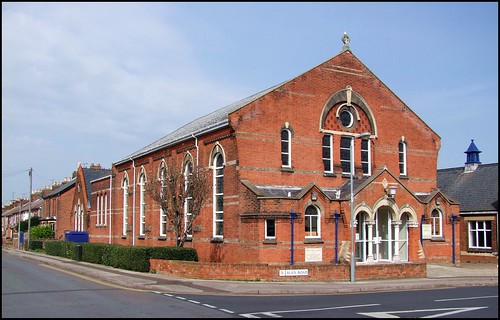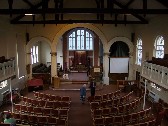Methodism in Suffolk

Most of us know that the Methodism dates from the 18th century and was led by John Wesley who, with his brother Charles, also wrote many of the traditional hymns that we sing in Christian churches today.
History:
Norma Virgoe has written books about the history of Methodism and John Wesley and is the editor of the Wesley Historical Society (East Anglia). She kindly agreed to tell us more:
John Wesley was an ordained Church of England priest, and he never left the Church of England. He believed that anybody could be ‘saved’ as long as they accepted Jesus as their saviour, and that God would forgive their sins. He regarded Methodism as a ‘yeast’, within the Church of England but he always insisted that Methodist services were at a different time from the Church of England services and that his congregation should attend both. When he first invited to preach in the open air, he felt this was very distasteful, but was amazed at the response when thousands of people attended. He realised this was a way to reach people who might never go into a Church of England church.
Increasingly pulpits were denied to John Wesley, and Methodist preachers met an enormous amount of hostility, some encouraged by the local priest. It became important to find places where people could be sheltered from the weather, could concentrate on the service – and kept safe from the mob who attacked the preachers and those listening. People went to hear the preachers as it was unusual to find someone standing up in a marketplace preaching the Gospel, but they also liked the message that God cares about you personally… it wasn’t about the Lord in his manor and his servants, all sitting in pews in church.
The many Methodist societies began meeting in farmhouses, cottages and barns, then congregations started to build their own premises. The chapels provided a religious life but also a social life with tea meetings, speakers, lantern slides, and Sunday School for the children. Every member had to meet in weekly class of 10 or 14 people with a leader, to talk about their own spiritual journeys.
After John Wesley died, in 1791, the annual Conference, the governing body of Methodism, wanted to retain the tight grip he had held, but this was resented by some members and there were breakaway groups almost immediately. In the early 19th century, a group in Staffordshire held huge outdoor meetings again. Facing disapproval, that group also broke away. They became known as the Primitive Methodists.
In a Wesleyan church they would sing hymns and would have used the Anglican prayer book for their services. The Primitive Methodists service was much more emotional with heartfelt spontaneous prayers and sermon, appealing to people’s emotions. They also had women preachers. Although many of his preachers had not liked it, John Wesley had encouraged certain women whom he felt had been given a gift to preach by God. Many of his Methodist colleague preachers were not happy with this but did not actively oppose him. Then, after he died, Conference forbad Women to reach in the pulpit although, of course, they spoke in the classes –that was allowed and often the class leader was a woman.
In the late 1840’s anonymous ‘Flysheets’ were published and distributed in chapels criticising the ever more authoritative Methodist hierarchy, and at the annual conference in 1849 three ministers, who refused to affirm that they were not involved, were expelled without proof, losing their jobs and homes. Horrified congregations held protest meetings and those members were expelled, along with any sympathetic ministers. Hundreds of Methodists left the church, (especially in Norfolk), and set up congregations as the Wesleyan Reformers, often taking over the former chapels.
Eventually several of the breakaway groups joined up to became the Free Methodists.
Unlike in Norfolk, Methodism started later in Suffolk. In 17th and 18th centuries early dissenters, such Baptists and Congregationalists, were already well established in Suffolk, appealing especially to the small landowners, so when Methodism came it was difficult for them to get land on which to build their chapels. The Primitive Methodists in particular had very little money and faced great opposition.
Although John Wesley spent time in Suffolk, it was almost always on the way to and from Norwich, before going on to Yarmouth and Lowestoft. He opened a chapel in Lowestoft in 1776, and, amazingly, he went to North Cove (which must have been just a hamlet then), six times! In Newmarket he stayed overnight but never preached there, and he went to Ipswich just once, for half an hour, but just because they couldn’t get any horses at Copdock!
(from an interview between Norma Virgoe and Rachel Sloane)

Methodism today: (see explanations of terminology below)
The three major strains of Methodism (Wesleyan, Primitive and United Methodists) joined together as the Methodist Church of Great Britain in 1932. Worldwide there are approximately 70-80 million Methodists.
Many of John Wesley’s original ideas are still features of Methodism today: local un-ordained preachers, ordained ministers serving a limited time in a church before moving on, the annual covenant service, a ‘class ticket’ for members, and the way the structure is set up with ‘circuits’ and ‘districts’. (see below).
The ban on gambling was lifted relatively recently although that is still a sensitive subject with some Methodists, and alcohol is still not permitted on Methodist premises.
There are over 40 Methodist churches and chapels in the main ‘circuits’ in Suffolk. (Bury St Edmunds, Lowestoft and East Suffolk, Waveney Valley Ecumenical Partnership, Haverhill, Ipswich and Thetford, Diss & Mildenhall. There is at least one more in the Ely and Newmarket circuit.)
Services:
A Methodist church service includes prayers, Bible readings, a sermon and congregational hymn singing, but it is different from a Church of England service in several ways.
District Chair, Rev Julian Pursehouse, explained that “Methodism is less liturgical, of a freer form and less bound by recited prayers. There are no sung responses in Methodism, they use different hymn books and do not recite psalms.”
What are the main challenges Methodism is facing nowadays? “
“Declining elderly congregations, availability of ordained ministry, Covid financial pressures and struggles regarding lay leadership (for example finding people willing to take on voluntary positions such as circuit treasurers, circuit stewards and even some district roles.”
The terminology of Methodism:
The Minister – is the ‘vicar’ equivalent- and he or she lives in a church-owned house called ‘a manse” rather than a vicarage.
Local preachers conduct around two-thirds of Methodist Sunday services. They are trained lay volunteers. Originally, the term ‘local preacher’ showed the difference between those who stayed in a local area and those who moved around the country as ministers (presbyters).
Church stewards are lay volunteers who manage each church.
Methodist churches/chapels are in a ‘Circuit’… a local group of churches, led by a Superintendent Minister.
Circuits belong to a ‘District’. They produce a quarterly ‘Plan’ which lists which ministers and local preachers are at each church on a Sunday.
The District Chair wouldbe the equivalent of a bishop but there are a number of distinctions between the roles.
A District Synod sets the policy for the district, linking the Conference and the Connexional Team that links the churches and circuits.
Methodists are governed by Conference which is a democratically elected body and meets annually at different locations around the country. The Methodist Council undertakes the ongoing work.
The President (from the clergy) and Vice-President (lay representative) preach across the country and are a focus for leadership around the Connexion and churches, offering visits to encourage. They are the public face of the church to the surrounding world and society. In the event of a major disaster, there would be a public statement from the President.
(Thank you to District Chair, Rev Julian Pursehouse for his help with this terminology)
(This article was first published in the Suffolk Historic Churches Trust Newsletter, Autumn 2021)